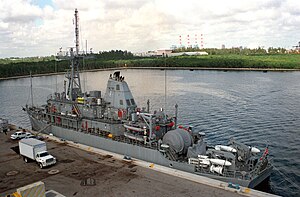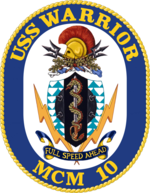
USS Ponce, is an Austin-class amphibious transport dock, formerly in service with the United States Navy. She has been the only ship of the Navy named for Ponce in the Commonwealth of Puerto Rico, which in turn was named after the Spanish explorer Juan Ponce de León, the first governor of Puerto Rico and the European discoverer of Florida. Her keel was laid down on 31 October 1966 by the Lockheed Shipbuilding and Construction Company of Seattle, Washington. She was launched on 20 May 1970 sponsored by Florence W. Hyland, the wife of Admiral John J. Hyland, and commissioned on 10 July 1971. She spent most of her career based on the East Coast and operating in the Atlantic Ocean and Mediterranean Sea, serving in Operation Desert Shield and supporting US operations in the 2011 Libyan Civil War.

The Seventh Fleet is a numbered fleet of the United States Navy. It is headquartered at U.S. Fleet Activities Yokosuka, in Yokosuka, Kanagawa Prefecture, Japan. It is part of the United States Pacific Fleet. At present, it is the largest of the forward-deployed U.S. fleets, with 50 to 70 ships, 150 aircraft and 27,000 Sailors and Marines. Its principal responsibilities are to provide joint command in natural disaster or military operations and operational command of all US naval forces in the region.
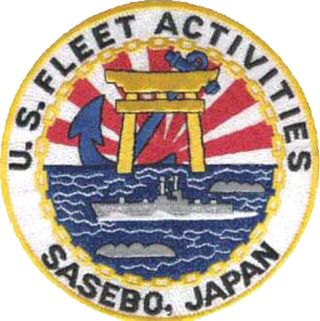
U.S. Fleet Activities Sasebo is a United States Navy base, in Sasebo, Japan, on the island of Kyūshū. It provides facilities for the logistic support of forward-deployed units and visiting operating forces of the United States Pacific Fleet and designated tenant activities.
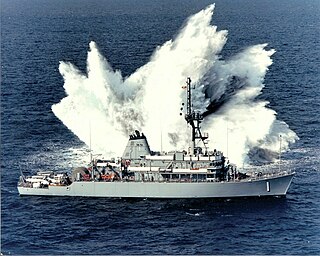
USS Avenger (MCM-1) was the lead ship of her class of mine countermeasures ship, and the third U.S. Navy ship of that name.

USS Guardian (MCM-5) was an Avenger-class mine countermeasures ship of the United States Navy, and was the second Navy ship to bear that name. The hulls of the Avenger-class ships were constructed of wood with an external coat of fiberglass.
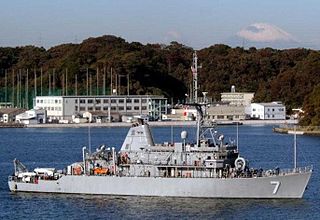
USS Patriot (MCM-7), is an Avenger-class mine countermeasures ship of the United States Navy, and is the third Navy ship of that name. The hulls of the Avenger-class ships are constructed of wood with an external coat of fiberglass.

USS Pioneer (MCM-9), an Avenger-class mine countermeasures ship of the United States Navy, and is the ninth ship of the class, and the second Navy ship of that name.

USS Chief (MCM-14) is an Avenger-class mine countermeasures ship of the United States Navy. She was named for the former USS Chief (AM-315), which in turn was named in honor of all chief petty officers of the US Navy.

USS Ardent (MCM-12) is an Avenger-class mine countermeasures ship in the United States Navy.

USS Defender (MCM-2) was an Avenger-class mine countermeasures ship in the service of the United States Navy. She entered service in September 1989 and was decommissioned in October 2014.

USS Champion (MCM-4), an Avenger-class mine countermeasures ship, is the fourth U.S. Navy ship of that name.

USS Impervious (AM-449/MSO-449) was an Agile-class minesweeper acquired by the U.S. Navy for the task of removing mines that had been placed in the water to prevent the safe passage of ships.

USS Leader (AM-490/MSO-490) was an Agile-class minesweeper acquired by the U.S. Navy for the task of removing mines that had been placed in the water to prevent the safe passage of ships.

USS Adroit (AM-509/MSO-509) was an Acme-class minesweeper acquired by the U.S. Navy for the task of removing mines that had been placed in the water to prevent the safe passage of ships.

The Landsortclass mine countermeasures vessel were built by Swedish shipbuilding company, Kockums for the Swedish Navy and the Republic of Singapore Navy (RSN) between 1983 and 1996.
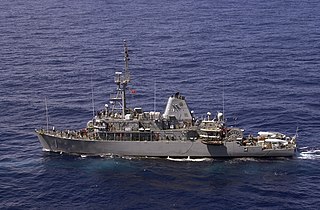
Avenger-class mine countermeasures ships are a class of 14 ships constructed for the United States Navy from 1987 to 1994, designed to clear mines from vital waterways. The ships have the hull designator MCM.

The fourth USS Scout (MCM-8) is an Avenger-class mine countermeasures ship of the United States Navy.

The Bedok class are mine countermeasures vessels of the Republic of Singapore Navy (RSN). They play an important role in the maritime security of Singapore, ensuring that the Singapore Strait and the sea lanes surrounding Singapore remain mine-free and open to international shipping. It is estimated that closure of Singapore's ports would result in direct trade losses amounting to more than US$1.2 billion daily, posing a serious threat to Singapore's economy. The four ships form the Sixth Flotilla of the RSN.

Expeditionary Strike Group SEVEN/Task Force 76 is a United States Navy task force. It is part of the United States Seventh Fleet and the USN's only permanently forward-deployed expeditionary strike group. It is based at the White Beach Naval Facility at the end of the Katsuren Peninsula in Uruma City, Okinawa, Japan.

The Fleet-class unmanned surface vessel, also called the Common Unmanned Surface Vessel (CUSV) and later the Mine Countermeasures Unmanned Surface Vehicle, is an unmanned surface vessel designed for the United States Navy to be deployed from Freedom and Independence-class littoral combat ships and intended to conduct mine and anti-submarine warfare missions. As of 2012 four units of the class have been built; the first was delivered to the U.S. Navy in 2008.
